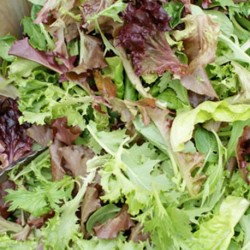



A great mixture of baby leaf varieties. Containing Lollo Verde (serrated, green), Batavian (cherry red; triple red; bright green) and Lollo Rossa (serrated, cherry red) types. Cut the leaves when they are about 10 - 15 cm long, cut only the longest ones so your plant will be a cut and come again crop. All of the varieties in this packet are suitable for whole head production too. Mix this packet with the lettuce Freckles for a truly stunning bowl of salad.
How to Grow Lettuce
A walk through the produce section of your supermarket will show you there are a ton of different types of lettuce available. There are seven cultivars of lettuce – Leaf, Romaine, Iceberg, Butterhead, Summercrisp, Stem and Oilseed; and within these cultivars there are multiple varieties.
Fresh lettuce from your own garden tastes ten times better than lettuce from the shop and it is simple to grow. Lettuce can be grown in the garden or you can grow it in containers, often referred to as “salad bowls”.
Starting Lettuce Seeds
You can start your lettuce seeds indoors to get a head start on your lettuce crop.
Lettuce can be sown in a seed tray and then as the plants begin to mature they can be moved to a larger pot. To start lettuce in a seed tray, you will want to use a seed or potting mix and fill the tray. Once the soil is in place, sprinkle the lettuce seeds in rows, placing approximately five seeds for every square inch. If you are planting more than one type of lettuce in your seed tray be sure to label your rows so you are able to identify your varieties later. Lettuce seed should not be placed in direct sunlight but should be in a bright, warm room.
Once the seeds germinate, which should happen quickly especially if you are germinating your seeds under a plastic or glass cover, you can thin out the weaker plants and move your lettuce plants to larger pots to allow them to continue to grow. Once the risk of frost has past you can begin to harden off your plants by moving them outdoors each day to become accustom to the temperatures outdoors however do not leave your plants outdoors overnight.
Lettuce seeds grow quickly, so it is important to give them room to grow. Select a small pot to start your seed in rather than a cell pack.
You can also sow your seed directly in the soil. Soil for lettuce needs to be well draining but needs to be able to hold water as lettuce requires a good amount of water to produce a decent tasting crop. If you are preparing your garden in the winter for planting in the spring, it would be ideal to add manure to the area you are planning to plant your lettuce crop so that it has a chance to break down in the soil.
Lettuce seeds prefer a sun spot in the garden. You will want to wait until the worst of the heavy frosts have passed before sowing your lettuce seeds outdoors, however if you choose to sow earlier you can use a cop cover for protection. Seeds should be sown at a depth of half an inch, leaving a foot between the rows. It is good practice to consider planting at staggered intervals, sowing your seeds every two weeks, so that you have a constant supply of lettuce in your garden rather than one big harvest as lettuce is ready to harvest in approximately six to twelve weeks depending on the variety (always check the label and plant accordingly. It is a good idea to make up a quick plan for your vegetable garden especially when using staggered planting so that you get the timing right).
Plants should be thinned when they reach two inches high and you should leave one foot in between plants. This will allow for proper air flow between plants and reduce the risk of pests and disease.
Companion Plants
Plants to plant near lettuce – beets, broccoli, brussels sprouts, cabbage, carrots, cauliflower, chives, garlic, kale, onions, radishes, strawberries.
Lettuce is also excellent interplanted in your flower garden. Lettuce is a foliage plant and it can be continually harvested throughout the season so placing it in your perennial bed or a container allows you to pick what you need and the plant will regenerate itself and still look nice in your garden. It is win-win especially for those who do not have a lot of room for a true vegetable garden.
Harvesting
Lettuce should always be harvested just before maturity for the best flavor. Lettuce should always be harvested in the morning for the best flavor.
Below are the various ways to harvest lettuce